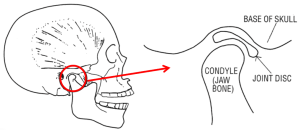Many people suffer from dizziness, earaches and pain of the face, head, neck, shoulder, or back without knowing the cause. Previously patients seeking help for these types of problems would go from “specialist” to “specialist” seeking a cure. Today, however, a condition termed TMJ (Temporomandibular Joint Syndrome) accounts for a large number of these previously uncured and painful ailments. These types of pain are symptoms of the syndrome not the problem itself. Correcting the problem rather than the symptoms is at the heart of TMJ treatment.
Your jaw joint is suspended beneath the skull by an intricate system of muscles and tendons. The jaw joints, also known as temporomandibular joints, are the most complex in the body.
The way your teeth fit together is called occlusion. When your teeth are not in proper relation to each other and to your jaw joints, the jaw automatically shifts to a new position in an attempt to compensate for the misalignment of your teeth; a condition known as malocclusion (teeth do not fit together properly).
When malocclusion exists, even what looks like a good bite could be putting pressure or strain on jaw joint and muscles as the jaw shifts to accommodate the teeth. Symptoms of misaligned teeth may be clenching, grinding, premature tooth wear and stress on the muscles and tendons. These may occur while awake or during sleep. These stresses result in headaches, muscular aches and pains in the face, neck, shoulders and back, dizziness, earaches and ringing in the ears.
In addition, these common conditions often relate to malocclusion and cause pain in and around the temporomandibular joint. There are other conditions which can affect the function and comfort of this joint and total body health.
These conditions include various diseases such as: arthritis, nutritional deficiencies, tumors, trauma and infections.
Before prescribing the proper treatment for your particular problem, a variety of diagnostic procedures may be necessary. A special series of radiographs (x-rays) may be taken of your jaw joint. This provides a clear picture of your own particular TMJ anatomy. This radiograph is also used for detecting disease in and around the jaw joint.
In order to study the relationship of your teeth and joints, it is necessary to see how the joints guide the jaw without interference from the reflexes and muscles which are always accommodating to the fit of the teeth. To do this, a record is taken measuring the relationship of the teeth to the jaw. This record of the joint guidance can then be reproduced on an instrument called an articulator, simulating your own particular jaw movements and bite relationship.
Then, without interferences from reflexes and muscles, your bite can be studied for interferences. Necessary treatment can then be prescribed.
After we have fully diagnosed the patient’s condition, there are a number of different types of treatment that we may recommend. Initial phases of treatment are for the muscles to relax and the jaw joint to become properly hinged. The second phase of treatment has its goal the correction of occlusion (proper meshing of teeth) so that the teeth are in proper alignment with the repositioned jaw joint. Various TMJ treatments are briefly explained.
Phase I Treatment
- Splint/Jaw Repositioner Appliances: These appliances are used in treatment to temporarily eliminate malocclusion problems and allow the head, neck and facial muscles to relax. A splint is a rigid acrylic mouthpiece that fits over the biting surfaces of the teeth. This appliance is used to slowly change the jaw hinge position by changing the biting surface of the plastic. These changes will continue approximately every two to three weeks for a period of 3 to 6 months.
- Ultrasound Muscle Stimulation: This type of therapy may be used during treatment to additionally help alleviate muscle pain caused by TMJ problems. This treatment is performed topically (to the surface of the skin) and can be done routinely in our office.

Phase II Treatment
- Occlusal Equilibration: In this procedure, the teeth are reshaped to eliminate misaligned biting surfaces.
This is done to alleviate pressure on individual teeth and allow the face and jaw muscles to relax on a permanent basis. This procedure can only be done if after Phase I treatment the tooth fit misalignment is minimal. - Orthodontics (Braces): Once proper jaw alignment has been reached through splint therapy, orthodontics may be necessary to achieve a proper tooth fit. Braces must be used if after jaw repositioning, misalignment is significant.
If you are experiencing the symptoms mentioned above, or have any questions, please call our office. We would be happy to discuss your concerns. It has been very rewarding for our team to help correct these problems for many in our dental family, giving them a vast improvement in the quality of life.





